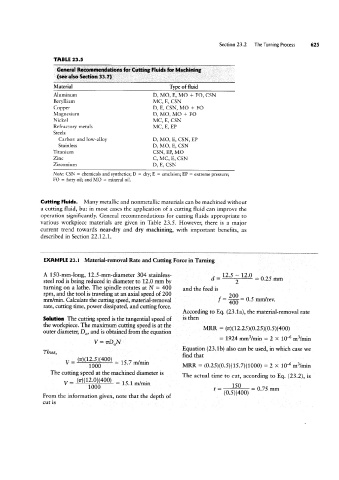Page 644 - 04. Subyek Engineering Materials - Manufacturing, Engineering and Technology SI 6th Edition - Serope Kalpakjian, Stephen Schmid (2009)
P. 644
Section 23.2 The Turning Process 625
TABLE 23.5
General Recommendations for Cutting Fluids for Machining
(see also Sectien 331)
Material Type of fluid
Aluminum D, MO, E, MO + FO, CSN
Beryllium MC, E, CSN
Copper D, E, CSN, MO + FO
Magnesium D, MO, MO + FO
Nickel MC, E, CSN
Refractory metals MC, E, EP
Steels
Carbon and low-alloy D, MO, E, CSN, EP
Stainless D, MO, E, CSN
Titanium CSN, EP, MO
Zinc C, MC, E, CSN
Zirconium D, E, CSN
Note: CSN = chemicals and synthetics; D = dry; E = emulsion; EP = extreme pressure
FO = fatty oil; and MO 1 mineral oil.
Cutting Fluids. Many metallic and nonmetallic materials can be machined without
a cutting fluid, but in most cases the application of a cutting fluid can improve the
operation significantly. General recommendations for cutting fluids appropriate to
various workpiece materials are given in Table 23.5. However, there is a major
current trend towards near-dry and dry machining, with important benefits, as
described in Section 22.12.1.
EXAMPLE 23.l Material-removal Rate and Cutting Force in Turning
A 150-mm-long, 12.5-mm-diameter 304 stainless- d = = (125 mm
steel rod is being reduced in diameter to 12.0 mm by
turning on a lathe. The spindle rotates at N = 400 and the feed is
rpm, and the tool is traveling at an axial speed of 200
mm/min. Calculate the cutting speed, material-removal f= ji-3-g-= 0.5 mm/rev.
rate, cutting time, power dissipated, and cutting force.
According to Eq. (23.1a), the material-removal rate
Solution The cutting speed is the tangential speed of is then
the workpiece. The maximum cutting speed is at the
MRR = (11')(12.25)(0.25)(0.5)(400)
outer diameter; D O, and is obtained from the equation
= 1924 rnm3/min = 2 X 10‘6 m3/min
V = 'rrDON
Equation (23.1b) also can be used, in which case we
Thus,
find that
_ (vr)(12.5)(400) __ .
V - ---1000 - 15.7 m/mm
MRR = (0.25)(0.5)(15.7)(1000) = 2 X 10`6 m3/min
The cutting speed at the machined diameter is The actual time to cut, according to Eq. (23.2), is
V ----V :_ 15.1 m/min bl:
= (1r)(12.O)(400)
t (0_5)(400) 0.75mm
From the information given, note that the depth of
cut is

